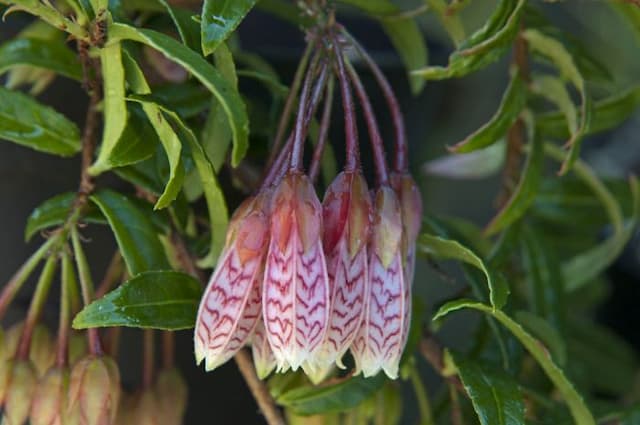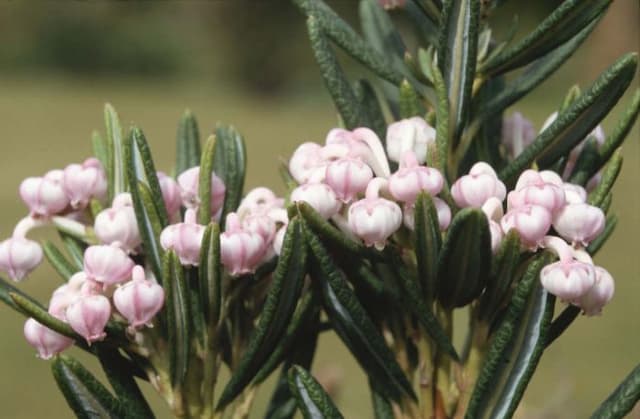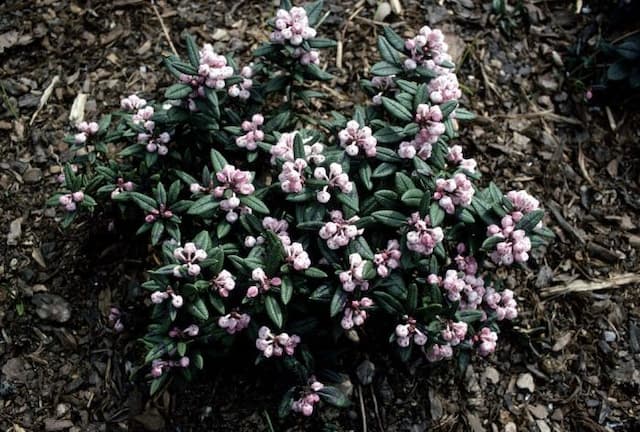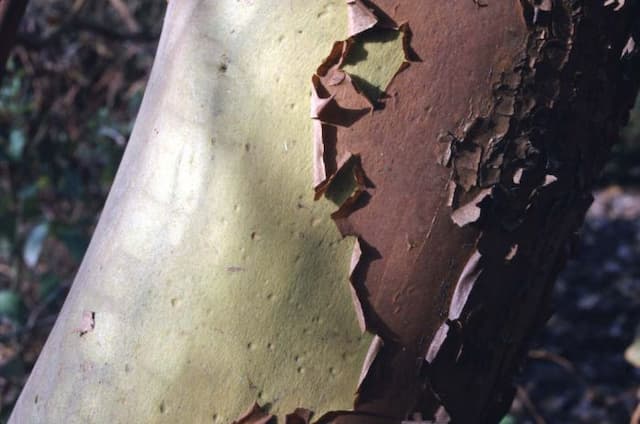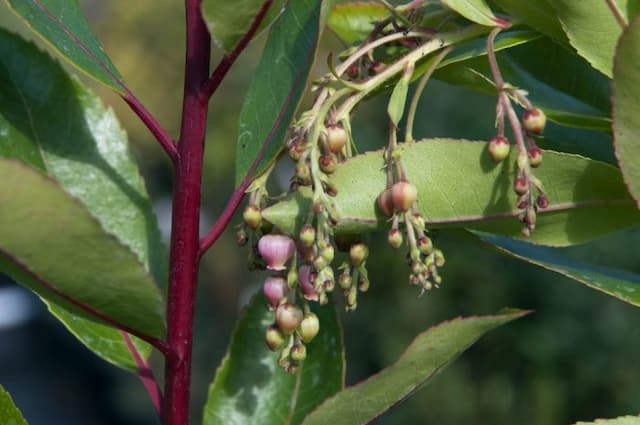Bell Heather Erica cinerea 'Cindy'











ABOUT
Erica cinerea 'Cindy' is a charming plant commonly known as bell heather. It is admired for its evergreen foliage and abundant bell-shaped flowers. The foliage typically consists of needle-like leaves that are small, narrow, and presented in whorls around the stems. These leaves are a dark green color, providing a lovely, dense backdrop for the flowers. The standout feature of this variety is its profusion of stunning flowers, which usually occur in shades of pink, creating a striking contrast against the greenery. These flowers are small, with a bell-shaped appearance, clustered toward the ends of the stems. The blooms are vivid and taut, giving the entire plant a colorful, frothy appearance when in full bloom. Blooming typically occurs during the summer months, transforming the plant into a vibrant, eye-catching specimen. Overall, Erica cinerea 'Cindy' is a delightful and picturesque plant, with a lush assembly of needle-like leaves and a profusion of bell-shaped pink flowers that make it a favorite among gardeners looking to add a splash of color to their garden palettes.
About this plant
 Names
NamesFamily
Ericaceae
Synonyms
Bell Heather, Twisted Heath
Common names
Erica cinerea 'Cindy'.
 Toxicity
ToxicityTo humans
Bell heather (Erica cinerea 'Cindy') is generally not considered toxic to humans. There is no widespread documentation of toxicity in humans following the ingestion of this plant, and it is often deemed safe in typical garden or landscape exposure. However, as with any plant, individual allergic reactions or sensitivities can occur, so it is advisable to handle plants with care, especially if you lack certainty about your reactions or the plant's identity.
To pets
Bell heather (Erica cinerea 'Cindy') is also not known to be toxic to pets. It is generally considered safe around animals, as there is no significant evidence of harmful effects from the ingestion of this plant by common domestic animals such as dogs and cats. However, individual animals can exhibit varying sensitivities to different plants, and it's always best to monitor your pets and prevent them from consuming non-food plants, as a precautionary measure.
 Characteristics
CharacteristicsLife cycle
Perennials
Foliage type
Evergreen
Color of leaves
Green
Flower color
Pink
Height
1 foot (30 cm)
Spread
2 feet (60 cm)
Plant type
Shrub
Hardiness zones
6
Native area
Europe
Benefits
 General Benefits
General Benefits- Attracts Pollinators: Erica cinerea 'Cindy' attracts bees and butterflies, which are essential for the pollination of plants in the garden.
- Low Maintenance: This plant is relatively easy to care for, requiring minimal attention once established.
- Drought Resistant: Once established, it has good resistance to drought, making it suitable for dry climates or water-wise gardens.
- Year-Round Interest: Throughout the year, this plant provides visual interest with its foliage and flowers peaking in the summer months.
- Ground Cover: Its growth habit makes it an excellent ground cover, helping to suppress weeds and protect soil from erosion.
- Decorative: The pink flowers of Erica cinerea 'Cindy' are ornamental, and they can add a splash of color to rockeries, borders, and garden beds.
- Winter Hardiness: It is capable of withstanding cold temperatures and can thrive in many climates subject to the right conditions.
- Soil Adaptability: While preferring well-drained, acidic soil, it can adapt to a range of soil types if they are not waterlogged.
- Long Blooming Period: It has a long flowering season, often blooming from early summer well into fall, providing long-lasting beauty.
 Medical Properties
Medical PropertiesThis plant is not used for medical purposes.
 Air-purifying Qualities
Air-purifying QualitiesThis plant is not specifically known for air purifying qualities.
 Other Uses
Other Uses- Bonsai: Erica cinerea, also known as Bell Heather, is sometimes used for bonsai due to its small leaves and ability to tolerate pruning, allowing it to be sculpted into miniature tree forms.
- Fairy Gardens: This plant is often included in fairy garden designs for its fine foliage and delicate flowers, adding a touch of whimsy and enchantment to the miniature landscapes.
- Natural Dye: The flowers and stems of Bell Heather can be used to produce a natural dye, which has historically been used for coloring wool with a range of pinks and purples.
- Photographic Subject: Its vibrant purple flowers make Bell Heather a popular subject for garden photographers and botanical illustrators, capturing its beauty in different art forms.
- Artisan Crafts: Dried Bell Heather can be used in the creation of artisan crafts, such as wreaths, floral arrangements, and potpourri, offering a rustic charm to handmade items.
- Floral Butter: The blossoms of Bell Heather can be infused in butter to create a floral spread with a hint of color and a mild flavor, adding an unexpected twist to culinary creations.
- Eco-Friendly Confetti: Dried flowers of the Bell Heather can serve as biodegradable confetti for outdoor celebrations, providing an environmentally friendly alternative to traditional paper confetti.
- Living Mulch: When planted densely, Bell Heather can act as a living mulch, conserving soil moisture and suppressing weeds, aiding in the maintenance of garden beds.
- Education: The plant can be used to teach botany and horticulture students about heathland ecosystems and the specific growing requirements of heather species in gardens and restoration projects.
- Seasonal Decorations: Erica cinerea can be incorporated into seasonal decorations, such as autumn and winter displays, for its evergreen foliage and colorful flowers lasting late into the year.
Interesting Facts
 Feng Shui
Feng ShuiThe plant Bell Heather is not used in Feng Shui practice.
 Zodiac Sign Compitability
Zodiac Sign CompitabilityThe plant Bell Heather is not used in astrology practice.
 Plant Symbolism
Plant Symbolism- Loneliness: Erica cinerea, commonly known as Bell Heather, is known for growing in poor, rocky soils often in isolated patches, symbolizing solitude or loneliness.
- Admiration: Bell Heather's beautiful, bell-shaped flowers are associated with admiration and can be given to someone you hold in high regard or esteem.
- Protection: In some folk traditions, it is believed that Heather has protective qualities, possibly due to its hardiness and the way it can dominate a landscape.
- Good Fortune: Heather is often thought to bring good luck, especially within Scottish folklore where it is held in high regard.
- Independence: Its ability to thrive in harsh environments also symbolizes independence and self-reliance.
 Water
WaterBell Heather should be watered thoroughly when the top inch of the soil feels dry to the touch, roughly once or twice a week depending on environmental conditions. Ensure that the soil is well-draining to prevent root rot. During the growing season, increase watering slightly, and decrease it in the winter when the plant is not actively growing. On average, use about a gallon of water every two weeks, adjusting for rainfall and temperature changes that might affect the plant's needs.
 Light
LightBell Heather thrives best in full sun to partial shade with at least six hours of sunlight per day, making it suitable for sunny borders or open gardens. Avoid placing it in deep shade as this can lead to poor blooming and leggy growth. An eastern or southern exposure is ideal for providing the bright, indirect light that Bell Heather prefers.
 Temperature
TemperatureBell Heather prefers cooler temperatures and can generally withstand a range from 40 to 70 degrees Fahrenheit. It is hardy and can survive brief periods of temperatures down to 20 degrees Fahrenheit, but it should be protected from prolonged exposure to extreme cold. For optimal growth, maintain an environment where temperatures stay within the range of 50 to 65 degrees Fahrenheit.
 Pruning
PruningPrune Bell Heather in late summer or early fall, after the blooms have faded, to encourage new growth and maintain a compact shape. Pruning helps to prevent the plant from becoming too woody and encourages a flush of new foliage. It's often enough to prune once a year, but if the plant becomes overgrown, additional light pruning in the spring can be beneficial.
 Cleaning
CleaningAs needed
 Soil
SoilFor Bell Heather (Erica cinerea 'Cindy'), a well-draining acidic soil mix is optimal, with a pH between 4.5 and 5.5. The best soil mix can consist of peat moss, sand, and loamy soil in equal parts to ensure proper aeration and moisture retention.
 Repotting
RepottingBell Heather should be repotted every two to three years or when it outgrows its current container. It's important to use an acidic soil mix and avoid compacting the soil during repotting.
 Humidity & Misting
Humidity & MistingBell Heather thrives best in moderate humidity conditions, generally around 50-70%. It prefers not to be in extremely dry environments but also does not need the high humidity required by some tropical plants.
 Suitable locations
Suitable locationsIndoor
Ensure bright light, acidic soil, moderate humidity.
Outdoor
Plant in well-drained, acidic soil, full sun to partial shade.
Hardiness zone
4-9 USDA
 Life cycle
Life cycleErica cinerea 'Cindy', commonly known as Bell Heather 'Cindy', begins its life cycle as a seed, which under favorable conditions germinates to develop a small root system and shoots that emerge above the soil. The seedling stage sees the young plant establishing its root system and producing its first true leaves, eventually forming a small shrub. As the plant matures, it enters the vegetative stage where it grows larger, developing a woody stem structure and dense foliage. During the reproductive stage, usually in summer, Bell Heather 'Cindy' produces distinctive purple-pink flowers that attract pollinators and, after pollination, will produce seed capsules. At the end of the flowering season, seeds are dispersed, completing the cycle. Over many years, the plant continues to grow and reproduce, maintaining its life cycle, and can spread vegetatively through layering, where branches touching the ground develop their own roots.
 Propogation
PropogationPropogation time
Late summer
The most popular method to propagate Erica cinerea 'Cindy', commonly known as bell heather, is through semi-hardwood cuttings. This is typically done in late summer through early fall. To propagate, you would select a healthy, non-flowering shoot and cut a piece around 2 to 4 inches (5 to 10 centimeters) long, just below a leaf node. The lower leaves are stripped off and the base of the cutting is dipped in rooting hormone to encourage root development. Then the cutting is inserted into a well-draining soil mix composed of peat and perlite or sand, ensuring that the leaf nodes where the leaves were removed are beneath the soil surface. The pot is then placed in a warm area with bright, indirect light and the soil is kept moist but not waterlogged until roots have developed, after which the new plant can be gradually acclimatized to outdoor conditions and finally planted out into the garden.
